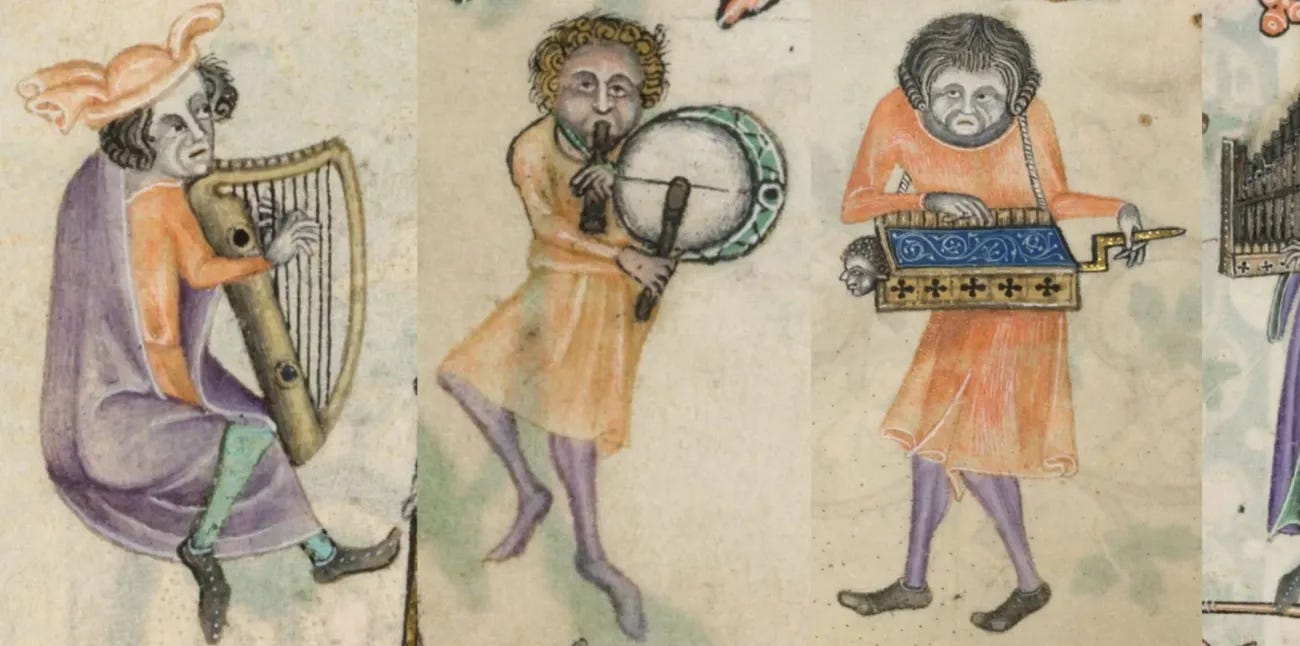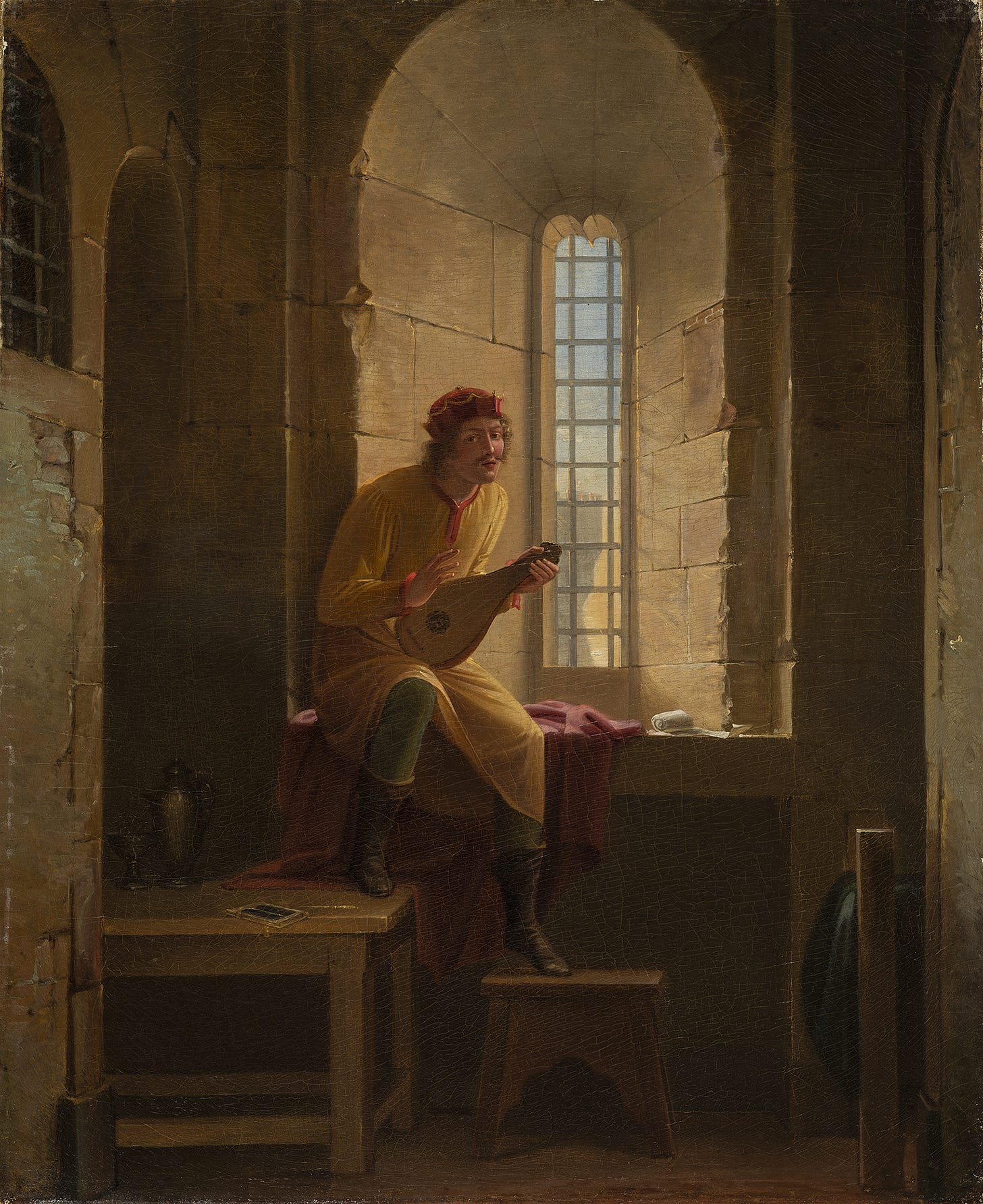Well, we have come full circle on our troubadour series. We kicked if off with a consideration of Lady Gaga and the Crusades (yes, really), and then went deep on the troubadour composers. The first episode, in case you missed the rest of the series, started here.
As we’ve alluded to a few times, the troubadour heritage was in Richard the Lionheart’s blood. His great-grandfather William IX was the so-called “first troubadour,” and that tradition continued for Richard. He apparently composed a number of songs, but one of them in particular has survived, words and melody intact. An interesting historical footnote to an amazing military and kingly career.
It’s winter of 1192 and Richard has shipwrecked on the shores of Leopold of Austria, whom he so thoroughly disrespected in the Holy Land. Ah, delicious irony. Were it fiction, it would not be believable. He’s rapidly taken into custody and held hostage in Dürnstein Castle in Austria. There’s a ransom out for him, an earth-shattering figure, 150,000 marks, two or three times the annual income of the English crown. In a cold, snowy castle high on a mountain, he waits for the ransom to be gathered. And he writes a song. Ja Nus Hons Pris. “No man a prisoner…”
No prisoner can tell his honest thought
Unless he speaks as one who suffers wrong;
But for his comfort as he may make a song.
My friends are many, but their gifts are naught.
Shame will be theirs, if, for my ransom, here —
I lie another year.
—translation, Lady Silence de Cherbourg
It goes on like that a bit, becoming increasingly maudlin, but then, can you blame him?
His time in Dürnstein gives rise to another legend, amongst so many about him. The legend of Blondel.
The Legend of Blondel
The legend goes something like this: nobody knows where Richard is. He’s lost. Everyone is trying to find him. His loyal troubadour, Blondel, wanders the countryside, singing a song he and Richard wrote together. Outside Dürnstein, he sings the first verse, and from a high tower, he hears the second verse come down to him, by a plaintive voice. And he knows he has found Richard.
There are variations on this legend: Blondel is Richard’s wife Berengaria in disguise, Blondel is Richard’s lover, and so on, and the tale would be told and retold even into the 18th, 19th, and 20th centuries.1
In reality, Richard’s location was no secret, and there’s no evidence to support this tale. Like many things “known” about Richard, the story is likely apocryphal.
Yet there is a core of truth to it, and it leads towards the end of the troubadours.
Blondel seems to be historical and there are twenty or so songs ascribed to this name. He is usually identified as Jean II of Nesle (d. 1241), or perhaps his father Jean I (d. 1202). Jean I took part in the Third Crusade and so likely knew Richard. But the timing suggests it’s the son, Jean II, that we are looking for, as Jean I died while Richard was in captivity. Here’s a Blondel song, in case you want a taste:
Jean II went on the Fourth Crusade, and later took part in the notorious Albigensian Crusade.
The last of the troubadours
The Albigensian Crusade (1209–1229) was a brutal Catholic military campaign launched by Pope Innocent III to eliminate the Cathar heresy in southern France, resulting in mass persecution, territorial conquest, and the expansion of French royal authority. (Note: Not all Crusades were Christian vs. Muslim!) The Cathers were a semi-mystical Christian sect that opposed the Catholic Church’s authority. The Crusade destroyed the courts of southern France that provided the key support for the troubadours. While of course no tradition just “stops,” this period marked the end of the Troubadour tradition in southern France, and one of those troubadours, Guiraut Riquier, is often called The Last Troubadour, though that is not strictly true.
Guiraut survived the Albigensian Crusade, wrote songs about it, and after about 1260 had made his way to the courts of Alfonso X. One his letters to Alfonso still survives, dealing with troubadours and jongleurs.
Wrap-up and Bibliography
Hope you’ve enjoyed learning a bit about the troubadours. To them we owe our notions of chivalry, good and bad, much of the Arthurian tradition, and the romance novel as we know it today. Of course, the term itself lives on, to be used casually to describe any crooning musician or wandering mistrel.
I’ve listened to a great deal of this music, and there are a few standout groups: The Martin Best Ensemble in various configurations, Alla Francesca, Ensemble Tre Fontane, Oni Wytars Ensemble, and many more. A playlist of many of my favorites is here:
In writing this series I’ve made use of a number of books, all worth reading if you want to know more.
Gillingham, Richard I
Boyle, The Troubadour’s Song
A. S. Cline, From Dawn to Dawn: Troubadour Poetry
Kehew, Lark in the Morning: the verses of the troubadours. (including translations by Ezra Pound and W. D. Snodgrass)
Paul Blackburn, Proensa: An Anthology of Troubadour Poetry.
Marisa Galvez, Songbook: How Lyrics Became Poetry in Medieval Europe
OK, next post, we’re back to blood or mayhem or swords, or some such. Or maybe Crusader Cannibals. Seriously.
https://en.wikipedia.org/wiki/Blondel_de_Nesle







